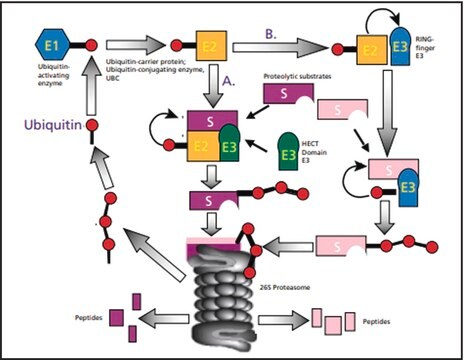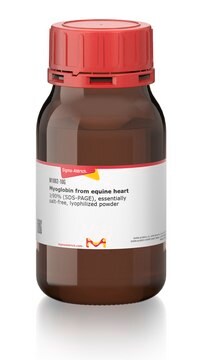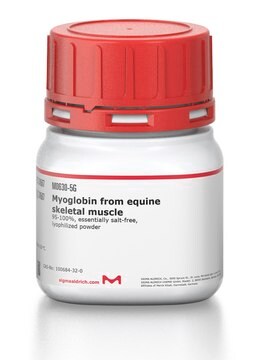U6253
Ubiquitin from bovine erythrocytes
BioUltra, ≥98% (SDS-PAGE), essentially salt-free, lyophilized powder
Sinónimos:
ATP-dependent proteolytic factor, Ub
About This Item
Productos recomendados
biological source
bovine erythrocytes
product line
BioUltra
assay
≥98% (SDS-PAGE)
form
essentially salt-free, lyophilized powder
storage condition
(Tightly closed. Dry)
technique(s)
western blot: suitable
impurities
salt, essentially free
solubility
water: 1 mg/mL, clear, colorless
UniProt accession no.
storage temp.
2-8°C
Gene Information
bovine ... LOC(101902760)
¿Está buscando productos similares? Visita Guía de comparación de productos
Categorías relacionadas
General description
Ubiquitin is a highly conserved regulatory protein. It is found in all eukaryotic cells and is virtually identical across all forms of life including yeast, humans, and plants. ubiquitin structure contains seven Lys residues and an N-terminus, all of which are target sites for ubiquitination.
Application
Ubiquitin from bovine erythrocytes can be used for in vitro ubiquitinylation assay. The product can also be used as a marker in western blotting.
Biochem/physiol Actions
Preparation Note
Antibody
Storage Class
11 - Combustible Solids
wgk_germany
WGK 3
flash_point_f
Not applicable
flash_point_c
Not applicable
ppe
Eyeshields, Gloves, type N95 (US)
Certificados de análisis (COA)
Busque Certificados de análisis (COA) introduciendo el número de lote del producto. Los números de lote se encuentran en la etiqueta del producto después de las palabras «Lot» o «Batch»
¿Ya tiene este producto?
Encuentre la documentación para los productos que ha comprado recientemente en la Biblioteca de documentos.
Nuestro equipo de científicos tiene experiencia en todas las áreas de investigación: Ciencias de la vida, Ciencia de los materiales, Síntesis química, Cromatografía, Analítica y muchas otras.
Póngase en contacto con el Servicio técnico






